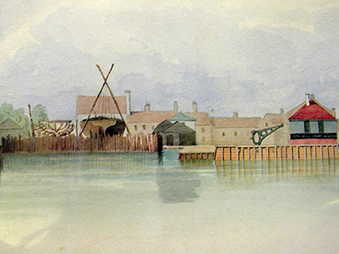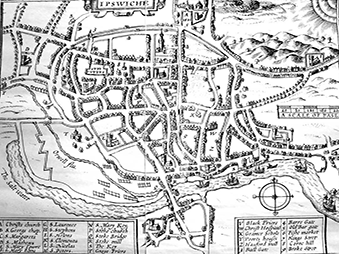Deeds
Individual deeds when separated from their original bundles are often of limited use. Antiquarians and collectors might choose an old document simply for its appearance and antiquity and discard later documents that may have been more useful. Occasionally scattered deeds can be linked together and connected to other sources but that is a time-consuming process. In well-catalogued collections it is not necessary to examine the deeds, as the main details appear in the catalogue. Additional details, such as the property boundaries may not appear in the catalogue and then the deeds will have to be examined.
When confronted with a bundle of deeds, the first document to look for is an 'abstract of title' as this document, which can be quite lengthy, is a summary of the contents of the other documents. In the deeds themselves, the property description beginning ‘All that …’ is of the greatest interest. Most of the property description will be formula. The phrase follows after the naming of the parties and recital clauses of previous conveyances which all begin with the word ‘whereas’. With bundle of deeds, all that is necessary is to compare the property description in the oldest deed with that of the most recent and note any changes, if the changes are significant it might be necessary to examine further deeds in the bundle.
Deeds can be complex and a word such as 'lease' may have a variety of meanings. In deeds of lease and release it is a method of conveyance, but other leases can be mortgages or simply tenancy agreements.
Bundles of deeds have been used for various archaeological reports as a means of examining a site history as far back as the early seventeenth century. When used in a systematic manner, the details contained in deeds provide a series of fixed points that can be expanded using other sources to repopulate entire streets or areas of the town.
Enrolled Deeds
In the Ipswich Borough records, properties can be traced back to the medieval period because, from as early as 1294, transcripts of deeds of burgage tenements were enrolled in recognizance rolls. The recognizance rolls continued through to 1425. Later enrolments from 1438 were contained in the ‘Dogget’ Rolls and Petty Court Books 1601-1843. The problem for a researcher is that until 1733, many of the records were written in Latin. A calendar of the earlier recognizance rolls has been published by Martin (1973).
Vincent Redstone (1853-1941) was a schoolmaster at Woodbridge Grammar School from 1880 until his retirement in 1921 and also acted as the archivist for Ipswich Borough Council. He had sufficient time to translate and transcribe nearly all of Ipswich’s early borough records then in the care of the borough. There are two sets of the 25 volumes of his transcriptions. The transcriptions given in the set on open access on the shelves of the record office are not as full as those in the set of his transcriptions held in the Library reserve collection (ref. 942.64 Ips/Stack). Not all the notebooks are fully indexed and the transcripts of the earlier material are in Latin.The books contain copies of his articles that were published in the East Anglian Daily Times.
The recognizance rolls and other borough records from as early as 1284 contain extracts from medieval wills and Redstone published a list of the early wills in the Proceedings of the Suffolk Institute in 1915. A transcript of Nathaniel Bacon’s 'The Annals of Ipswiche. The Lawes Customes and Governmt … of that Towne... 1654' was published in 1884 (Richardson).
Bacon (1593-1660) was the former Recorder and Town Clerk of Ipswich. Bacon’s aim was to “recollect those auncient memorialls remaining in scattered writings and records whereof noe recollection hath been formerly made and therby lay buried up as it were in a heape of rubbish”. Bacon had access to certain records (1431-1481) that have since been lost. The original published edition lacks an index but there is a separate bound typescript index available at the record office.
Common Soil, Foreshore Grants and Petty Rentals.
The right or licence of Ipswich’s burgesses to “build in the King’s waste places in the town, and to receive the farms and profits arising from them for their own use” was noted in the Patent rolls as early 1340 and in the borough’s Portmanmote Rolls there are references to some pieces of common soil upon the ramparts had been leased in 1303. Such grants could only be made once the original common use or function had ceased to be relevant. The size of each piece varies and the deeds and later rentals include measurements that can be used to identify some of the plots on the later maps.
The grants of foreshore and grants of common soil formed part of the same series, but it appears that they were later separated during a legal dispute over the foreshore. The rents arising from both grants appear in the petty rentals. Most of the rentals apart from that of 1542 are written in Latin. Some were transcribed by Redstone. The rentals of 1499, 1542 and 1570 have full descriptions of the parcels of land but that detail is missing from the later rentals of 1637 and 1672. The 1637 rental does mention public houses when their signs were placed on common soil (ref. C/3/3/4/1-3 & 7). In addition to the rentals there is a survey of the borough’s lands dated 1569 (ref. HD117/1). The grants themselves where they have survived are listed in full in the catalogue of the borough’s archives. Some grants made in the mid-fifteenth century were listed in Bacon’s Annals (Richardson).
Rate Books
There are Rate books for nearly all of Ipswich’s historic parishes. A number survive from 1572 onwards.
The reason for this is the ‘Act for Paving of the Town of Ipswich’ 1571 (13 Elizabeth I, c. 24). The title of the act obscures its additional purpose which was to regulate the appointment of ministers as the act ordered “The Bailiffs of Ipswich and Portmen there, the Churchwardens, and four of every parish shall have authority to tax upon every house, ground and tenement, free or copy, situate with the several parishes of Ipswich reasonable sums of Money to be yearly paid, as well toward the finding of a convenient stipendiary minister within every parish, as for the Reparation of the Churches there”.
Because the borough had responsibilities for the collection of rates, many of the early lists 1574 – 1651 are in a single volume (ref. C/3/2/2/2). Most of the lists are lacking in details beyond naming individuals and the amount they paid.
On folios 326v – 346v there is an undated tax list for the entire town c.1574. The list begins with the parish of St Margaret’s and is unusual in that it contains some subheadings. The list begins with Richard Waller’s garden ‘next Pountney Lane’ and then ‘Edmond Wythypoll esquire for the late dissolved Priory of Christchurch’ and then the subheadings ‘Tankard Strete’ with 11 properties, Baldwyns Lane 4 properties, ‘Carrystrete’ 40 properties beginning with ‘Mr Harbotle for his house’, ‘Warwroke Strete’ 2 properties, ‘St Margaret Strete’ 35 properties, ‘The Soame Strete’ 30 properties and finally ‘Brokestrete’ with 32 properties.
An early rate list for St Matthew’s is contained in the parish book 1572 – 1756 (ref. FB95/A2/1). The first document in this volume is the parish accounts dated 24 October 1574 that includes references to St George’s Lane and the site of the Chapel Yard. On folio 155 there is a taxation for the parish ‘according to the statute of 27 February 1572’, a further reference to the Paving Act.
Occasionally the rate lists will identify a known property such as a public house, but their greatest use is tracing the ownership of a property when the owner is mentioned in deeds back to when they are first mentioned in the rate lists. The rate lists occasionally make reference to the previous owner or it may be obvious that the property has passed to a new owner through inheritance.


